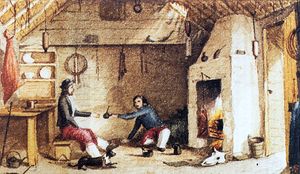East Falkland
| East Falkland | |
|---|---|
| Location | |
|
|
|
 East Falkland
|
|
| East Falkland shown within the Falkland Islands. | |
| Island group: | East Falkland |
| Names | |
| English name: | East Falkland |
| Spanish name: | Isla Soledad |
| Meaning of names: | Spanish: Isle of Solitude |
| Area and Summit | |
| Area: | 6,605 km2 (2,550 sq mi) |
| Area rank: | 1 |
| Highest elevation: | Mount Usborne 705 m (2,313 ft) |
| Population | |
| Population (2001): | 2197[1] |
| Population rank: | 1 |
| Main settlement: | Stanley |
| References: | |
| If shown, area and population ranks are for all islands and all inhabited islands in the Falklands respectively. | |
East Falkland (Spanish: Isla Soledad) the largest of the Falkland Islands in the South Atlantic, has an area of 2,550 sq mi (6,605 square kilometres) [2][3] and a coastline 1036.9 miles (1668.7 km)[3] long. Most of the population of the Falklands live in East Falkland, almost all of them living in the northern half of the island. The southern half, joined by a narrow isthmus, is known as Lafonia.
Contents |
Geography
The northern part of the island is hilly, and is crossed by a rugged range, the Wickham Heights, running east and west, and rising in some places to a height of just over 1968 ft (600m)[4]. The highest point, and the highest point in the whole island group, is Mount Usborne, 2,313 ft (705 m [5]), in the Wickham Heights. The remainder of the island consists chiefly of low undulating ground, a mixture of pasture and morass, with many shallow freshwater tarns, and small streams running in the valleys. The geology is mostly sandstone, with some quartzite and slate, and the soil often poor and acidic. Two fine inlets, Berkeley Sound and Port William, run far into the land at the northeastern extremity of the island.
The island is almost bisected by two deep fjords, Choiseul Sound and Brenton Loch-Grantham Sound which leaves the northern portion and Lafonia in the south, connected only by an isthmus just under 1.5 mi (2.5 km[4]) wide. The island contains many smaller bays, inlets and headland.
Other scenery includes stone runs, heathland, and bogs. Gypsy Cove is noted as a beauty spot.
Population and infrastructure
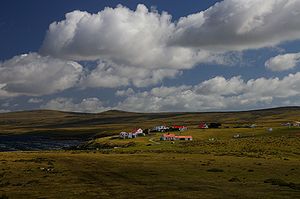
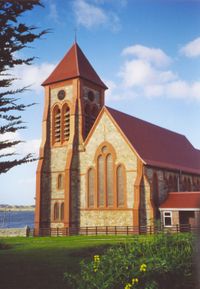
Stanley, the capital of the islands and the main seaport is in East Falkland. The islands' (Anglican) Christchurch cathedral is also in Stanley.
Port Louis, at the head of Berkeley Sound, was once the seat of government. However, the anchorage there was found to be rather too exposed and about 1844 a town was laid out, and the necessary public buildings were erected on Stanley Harbour, a sheltered recess within Port William.
Other settlements include Port Louis, Darwin, Port San Carlos, San Carlos, Salvador, Johnson's Harbour, Fitzroy, Mare Harbour, and Goose Green.
East Falkland also has two airports with paved runways, Port Stanley Airport and RAF Mount Pleasant. There is a lighthouse at Cape Pembroke near Stanley. East Falkland contains most of the archipelago's few roads.
Economy
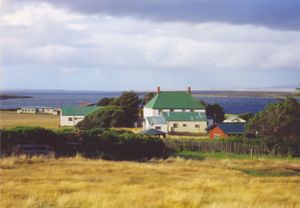
The main industries on the island are fishing, sheep farming, government, and tourism. Some oats are also grown, but due to high humidity and acidic soil, the land is mainly used for grazing.
As Stanley is the capital, and East Falkland is the most populous island, it performs an economic role as the hub of the archipelago. Many cruise ships now stop there.
A large economic role is also played by RAF Mount Pleasant, which has a number of British military personnel based there. Although these number a few hundred, their economic role in a population of under two thousand cannot be underestimated.
Smaller industries include horse and cattle farming, and there is also recent evidence to suggest possible valuable mineral deposits on the island.
Wildlife

Due to more intensive human settlement, East Falkland has the corresponding conservation problems. The warrah was one of the first casualties, as Darwin says in The Voyage of the Beagle:
- "The only quadruped native to the island is a large wolf-like fox (Canis antarcticus), which is common to both East and West Falkland. I have no doubt it is a peculiar species... Their numbers have rapidly decreased; they are already banished from that half of the island which lies to the eastward of the neck of land between St. Salvador Bay and Berkeley Sound. Within a very few years after these islands shall have become regularly settled, in all probability this fox will be classed with the dodo, as an animal which has perished from the face of the earth."
Rats have also been introduced, but despite this, the island has a great deal of marine life, including penguins of various kinds.
Guanacos were unsuccessfully introduced in 1862 to East Falkland south of Mt Pleasant where Prince Alfred hunted them in 1871 [1]. They have since become extinct, but are still on Staats Island
Charles Darwin surveyed the area's wildlife, while on HMS Beagle.
History

The first permanent settlement on East Falkland began with Louis de Bougainville establishing Port Louis on Berkeley Sound in 1764. The French settlement included a number of Bretons, and the islands became known as "Îles Malouines" (the islands of St Malo), later hispanicised as "Islas Malvinas". For years, Port Louis was the main settlement, not only on East Falkland, but the entire archipelago and a subject of controversy.
In October 1820, Colonel David Jewett, sought shelter in the islands after his ship, the frigate Heroina, was damaged in a storm. Jewett was an American privateer employed as captain by the Buenos Aires businessman Patrick Lynch who had obtained a corsair license for the ship from the Buenos Aires Supreme Director Jose Rondeau. On 6 November 1820 he raised the flag of the United Provinces of the River Plate at Port Louis and claimed possession of the entire archipelago in the name of the United Provinces of the South (which later became the United Provinces of The River Plate and ultimately Argentina). Eye witnesses present, such as James Weddell, opined that the ceremony was designed to establish a salvage claim over a French wreck.
In 1823, Argentina granted fishing rights to Jorge Pacheco and Luis Vernet. Their first expedition to the islands ended in failure and Pacheco abandoned the venture. Vernet persisted with a second expedition in 1826 also ending in failure due to the combination of the Brazilian blockade of Argentina and the conditions encountered. Vernet finally succeeded on establishing a permanent settlement at Puerto Soledad in 1828. Prior to both expeditions, Vernet had approached the British consulate in Buenos Aires seeking permission for his venture in the islands. Subsequently Vernet furnished the consulate with progress reports and urged the establishment of a permanent British garrison in the islands.
In 1829, Vernet approached the Government of Buenos Aires requesting that the settlement be supported by a naval vessel. That request was refused, instead Vernet was proclaimed to be Governor and authorised to act using his own resources. The British consul lodged a formal protest over the proclamation, which went unanswered, whilst Vernet assured the British consul that his interest was purely commercial and once more urged the British to establish a permanent presence in the islands. Vernet was the first person to be proclaimed Governor, although modern Argentine texts claim the Captains of the Heroina and Pachego as "governors".
"Puerto Luis" as it was renamed became a seal hunting base and small fishing port. Vernet later seized the American ship, Harriet, for breaking the monopoly he claimed on seal hunting; one that had not been recognised by the American or British Governments (both formally disputed the restrictions through their consuls in Buenos Aires). Property on board the ship was seized and the captain was returned to Buenos Aires to stand trial. Vernet also returned for the trial. The American Consul in Argentina protested the actions by Vernet, stating that the United States did not recognise Argentine sovereignty in the Falklands.
Therefore, the American consul dispatched the USS Lexington warship to the Puerto Luis to retake the confiscated property, as well as the "Superior" and "Breakwater" which had also been seized. As a result, the USS Lexington attacked Puerto Luis in 1832, an act which was later condoned by the American ambassador in Buenos Aires, who declared the Falkland Islands free from any power. There is some dispute as to the outcome of the attack, modern Argentina claims the settlement was destroyed whilst Duncan's log describes spiking the guns of the settelement and destroying the powder store. Duncan arrested the seven senior members of Vernet's settlement for piracy and provided transport to Montevideo for any member of the settlement who wished to leave. The majority of the population chose to leave claiming Vernet had mislead them about the miserable conditions in the islands. Following these events Vernet resigned as Governor, in 1832 the Argentine Government appointed as governor, Esteban José Francisco Mestivier, and sought to establish a penal colony in the islands (Mestivier's appointment was in fact the only Argentine appointment to follow the norms of the time and was properly gazetted). Shortly after his arrival in the islands Mestivier was murdered by his own men and the settlement was in chaos.
These events provided the spur for Britain to return to the islands, (See Re-establishment of British rule on the Falklands (1833)), requesting that the Argentine military presence leave on 3 January 1833 (although members of the settlement were encouraged to remain). "Puerto Luis" was initially renamed "Ansons Harbour" before reverting to "Port Louis" in line with the original French name of the settlement Port Saint Louis, and became a naval garrison and civilian settlement.
Shortly after this, the second voyage of HMS Beagle surveyed the island. The names of two settlements on East Falkland, Darwin and Fitzroy, commemorate Charles Darwin and Robert FitzRoy respectively. On the 15 March 1833, an unimpressed Darwin commented that
- After the possession of these miserable islands had been contested by France, Spain, and England, they were left uninhabited. The government of Buenos Aires then sold them to a private individual, but likewise used them, as old Spain had done before, for a penal settlement. England claimed her right and seized them. The Englishman who was left in charge of the flag was consequently murdered. A British officer was next sent, unsupported by any power: and when we arrived, we found him in charge of a population, of which rather more than half were runaway rebels and murderers. (The Voyage of the Beagle.)
In 1836, the island was surveyed by Admiral George Grey, and further in 1837 by Lowcay. Admiral George Grey, conducting the geographic survey in November 1836 had the following to say about their first view of East Falkland -
- We anchored a little after sunset off a creek called 'Johnson's Harbour'. The day having been cloudy with occasional showers, these islands at all times dreary enough, looked particularly so on our first view of them, the shores of sound, steep, with bare hills intersected with ravines rising from them, these hills without a tree and the clouds hanging low, gave them exactly the appearance of the Cheviots or a Scotch moor on a winter's day and considering we were in the May of these latitudes, the first impression of the climate was not favourable, the weather however, was not called, the thermometer was 63 degrees which is Howick mid-summer temperature.
In 1845 Mr Samuel Fisher Lafone, a wealthy cattle and hide merchant from Montevideo on the River Plate, obtained a grant of the southern portion of the East Falkland from the British government, He purchased this peninsula, 600,000 acres (2,400 km2) in extent, together with possession of all the wild cattle on East Falkland for a period of six years, for a payment of £10,000 down, and £20,000 in ten years from January 1, 1852. In 1851 the Falkland Islands Company, which had been incorporated by charter in the same year, bought Mr Lafone's interest in Lafonia, as the peninsula came to be called, for £30,000. Lafone himself never visited the islands. The remnants of this endeavour are the ruins at Hope Place and the stone corral at Darwin.
In 1859, Darwin was founded.
Although used for sheep farming since the early nineteenth century, East Falkland was dominated by cattle farming until the 1850s.
In 1925 the Bodie Suspension Bridge was built across a creek in Lafonia, and is said to be the southernmost in the world, and is still in pedestrian use today.
1982 invasion and Falklands War
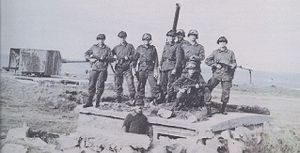
In April 1982, East Falkland was invaded by Argentina. Governor Sir Rex Hunt was informed by the British Government of a possible Argentine invasion on Wednesday 31 March. The Governor summoned the two senior Royal Marines officers of Naval Party 8901 to Government House in Stanley to discuss the options for defending the Falklands. Major Mike Norman RM was given overall command of the Marines due to his seniority, while Major Gary Noott RM became the military advisor to Governor Hunt. The total strength was 68 Marines and 11 sailors, which was greater than would normally have been available because the garrison was in the process of changing over. But their numbers were reinforced by 25 Falkland Islands Defence Force (FIDF) members. Their commanding officer, Major Phil Sommers, tasked the volunteer militiamen with guarding such key points as the telephone exchange, the radio station and the power station. Skipper Jack Solis, onboard the civilian coastal ship Forrest operated his boat as an improvised radar screen station off Stanley.
East Falkland was also the location of the bulk of the action in the Falklands War. As a result, some areas of the "Camp" in East Falkland are still heavily mined. Areas that saw intensive action included Goose Green, San Carlos, Mount Longdon and the Two Sisters ridge.[6]
List of East Falkland battles
- Battle of Goose Green
- Battle of Mount Harriet
- Battle of Two Sisters
- Battle of Mount Longdon
- Battle of Mount Tumbledown
- Battle of Wireless Ridge
Present day
Following the Falkland War, Britain increased its military presence on the East Falkland and invested heavily in improving facilities in Stanley and transportation around the islands, tarmacking many roads. The population has risen, due to the growth of Stanley, but has declined in the Camp. Most of the improvements in the islands have taken place on East Falkland.
References
 This article incorporates text from a publication now in the public domain: Chisholm, Hugh, ed (1911). Encyclopædia Britannica (Eleventh ed.). Cambridge University Press.
This article incorporates text from a publication now in the public domain: Chisholm, Hugh, ed (1911). Encyclopædia Britannica (Eleventh ed.). Cambridge University Press.- Southby-Tailyour, Ewen: Falkland Island Shores.
- ↑ "2001 Falkland Islands Census. Figure exclude persons aboard visiting vessels or the estimated number of people temporarily absent. It excludes serving military and their families, but not civilian staff at military bases.". 2001. http://www.falklands.info/background/census2001t.html. Retrieved 2010-03-05.
- ↑ Microsoft Encarta - Dead link
- ↑ 3.0 3.1 "Inventory of European data sources relevant for coastal erosion assessment in Europe (page 122)". European Commission. 2002. http://www.eea.europa.eu/data-and-maps/data/hydrodynamics-and-sea-level-rise/inventory_report/inventory_report/at_download/file. Retrieved 2010-03-05The source document only used kilometres and square kilometres in its text
- ↑ 4.0 4.1 P Turnbull (2004-03-2-). "Falkland Islands". South Seas: South Seas Companion. http://southseas.nla.gov.au/biogs/P000067b.htm. Retrieved 2010-03-05The source document only used metres
- ↑ "(Falkland Island) Location". The Falkland Islands Government. 2009. http://www.falklands.gov.fk/Location.html. Retrieved 2010-03-05The soure document used metres as it principal unit of measure and feet as a supplementary unit of measure
- ↑ Major Timothy J. Hannigan, USMC (1 April 1984). British Triumph on East Falkland "British Triumph on East Falkland". War since 1945 seminar. Marine Corps Development and Education Command, Quantico, Virginia 22134: Marine Corps Command and Staff College. http://www.globalsecurity.org/military/library/report/1984/HTJ.htm British Triumph on East Falkland. Retrieved 2010-07-24.
Picture Gallery (External link)
|
||||||||||||||||||||||||||||
